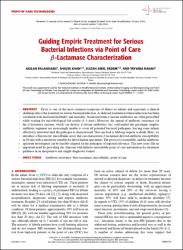| dc.contributor.author | Palanisami, Akilan | |
| dc.contributor.author | Khan, Shazia | |
| dc.contributor.author | Erdem, Sultan Sibel | |
| dc.contributor.author | Hasan, Tayyaba | |
| dc.date.accessioned | 10.07.201910:49:13 | |
| dc.date.accessioned | 2019-07-10T19:56:17Z | |
| dc.date.available | 10.07.201910:49:13 | |
| dc.date.available | 2019-07-10T19:56:17Z | |
| dc.date.issued | 2016 | en_US |
| dc.identifier.citation | Palanisami, A., Khan, S., Erdem, S. S. ve Hasan, T. (2016). Guiding empiric treatment for serious bacterial infections via point of care beta-lactamase characterization. Ieee Journal Of Translational Engineering In Health And Medicine-Jtehm, 4. https://dx.doi.org/10.1109/JTEHM.2016.2573305 | en_US |
| dc.identifier.issn | 2168-2372 | |
| dc.identifier.uri | https://dx.doi.org/10.1109/JTEHM.2016.2573305 | |
| dc.identifier.uri | https://hdl.handle.net/20.500.12511/2653 | |
| dc.description | WOS: 000379855500001 | en_US |
| dc.description | PubMed ID: 27602307 | en_US |
| dc.description.abstract | Fever is one of the most common symptoms of illness in infants and represents a clinical challenge due to the potential for serious bacterial infection. As delayed treatment for these infections has been correlated with increased morbidity and mortality, broad-spectrum beta-lactam antibiotics are often prescribed while waiting for microbiological lab results (1-3 days). However, the spread of antibiotic resistance via the beta-lactamase enzyme, which can destroy beta-lactam antibiotics, has confounded this paradigm; empiric antibiotic regimens are increasingly unable to cover all potential bacterial pathogens, leaving some infants effectively untreated until the pathogen is characterized. This can lead to lifelong sequela or death. Here, we introduce a fluorescent, microfluidic assay that can characterize beta-lactamase derived antibiotic susceptibility in 20 min with a sensitivity suitable for direct human specimens. The protocol is extensible, and the antibiotic spectrum investigated can be feasibly adapted for the pathogens of regional relevance. This new assay fills an important need by providing the clinician with hitherto unavailable point of care information for treatment guidance in an inexpensive and simple diagnostic format. | en_US |
| dc.description.sponsorship | National Institute of Health/National Institute of Biomedical Imaging and Bioengineering and Point of Care Technology in Primary Care through the Center for Integration of Medicine and Innovative Technology [U54 EB015408]; U.S. Department of Defense/Air Force Office of Research [FA9550-11-1-0331] | en_US |
| dc.description.sponsorship | This work was supported in part by the National Institute of Health/National Institute of Biomedical Imaging and Bioengineering and Point of Care Technology in Primary Care through the Center for Integration of Medicine and Innovative Technology under Grant U54 EB015408, and in part by the U.S. Department of Defense/Air Force Office of Research under Grant FA9550-11-1-0331. | en_US |
| dc.language.iso | eng | en_US |
| dc.publisher | Ieee-Inst Electrical Electronics Engineers Inc | en_US |
| dc.rights | info:eu-repo/semantics/openAccess | en_US |
| dc.subject | Antibiotic Resistance | en_US |
| dc.subject | Beta-Lactamase | en_US |
| dc.subject | Microfluidic | en_US |
| dc.subject | Point of Care | en_US |
| dc.title | Guiding empiric treatment for serious bacterial infections via point of care beta-lactamase characterization | en_US |
| dc.type | article | en_US |
| dc.relation.ispartof | Ieee Journal Of Translational Engineering In Health And Medicine-Jtehm | en_US |
| dc.department | İstanbul Medipol Üniversitesi, Rektörlük, Rejeneratif ve Restoratif Tıp Araştırmaları Merkezi (REMER) | en_US |
| dc.identifier.volume | 4 | en_US |
| dc.relation.publicationcategory | Makale - Uluslararası Hakemli Dergi - Kurum Öğretim Elemanı | en_US |
| dc.identifier.doi | 10.1109/JTEHM.2016.2573305 | en_US |
| dc.identifier.wosquality | Q2 | en_US |


















